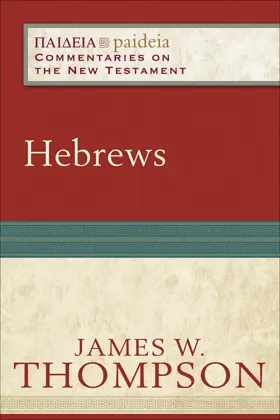

Hebrews
in Paideia Commentaries on the New Testament
Pages
336 pages
Publisher
Baker Academic
Published
12/1/2008
ISBN-13
9780801031915
Collections
This book appears in the following featured collections.
- New Testament Commentaries & Monographs by Princeton Theological Seminary
Reviews
This commentary is by far the most brief on the list, but Thompson’s work is very readable and will be useful for both scholar and layman. I think that this commentary might be the “first of the shelf” for the busy pastor. The commentary does an excellent job with the rhetoric of the letter, attempting to read the letter in the light of Greco-Roman homiletical tradition which was popular in the Hellenistic synagogue (13). He treats much of the writer’s use of the Hebrew Bible as midrash, a decidedly Jewish way of treating scripture. Hebrews 7 for example is a midrash on Gen 17:14-20 and Ps 110 (143). Thompson is also at home in the literature of the Second Temple Period, especially Philo. Commentaries on Hebrews must deal with parallels between the writer’s style and that of Philo of Alexandria, this commentary does so without losing sight of the biblical text. The commentary treats the English text with all Greek appearing in translation, sources cited in-text. There are numerous sidebars and occasional photographs in the commentary, something not usually including in scholarly works.
[Full Review]
Veteran Hebrews’ commentator James W. Thompson unlocks the secrets of Hebrews in this excellent commentary, part of the Paideia series from Baker Academic. The aim of the series is to comment on the canonical form of the book under consideration, with special attention to its theology and its literary, cultural, and social settings. Unlike many commentary series, Paideia does not offer a verse-by-verse exposition of the text. Rather, the textual units are commented on as literary and sense units, in order to help the reader grasp the flow of the book’s narrative or argument. Each section of the text under study is organized under three headings: “Introductory Matters”; “Tracing the Train of Thought”; and “Theological Issues.” The audience of the series is students, ranging from upper-divisional undergraduates to M.A. students in religion. Who better to write on what is perhaps the most difficult New Testament book to understand than this accomplished scholar and teacher? This commentary is so well done that even experts in the field can benefit from reading it. A clearly written introduction discusses the usual matters that readers should be familiar with in order to understand the form and function of a biblical book, as well as its origin, destination, and themes.
[Full Review]

